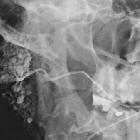panda sign of sarcoidosis
The panda sign of sarcoidosis is a gallium-67 citrate scan finding. It is due to bilateral involvement of parotid and lacrimal glands in sarcoidosis, superimposed on the normal uptake in the nasopharyngeal mucosa.
The presence of perihilar adenopathy adds the lambda distribution of increased uptake in the chest, which at times has been included in the description of the panda distribution.
The panda sign is not specific for sarcoidosis, although it is one of few disorders that affect the salivary and lacrimal glands symmetrically.
Since Ga-67 citrate accumulates in areas of inflammation and malignancy, the differential diagnosis for the symmetric bilateral accumulation in the lacrimal and salivary glands include lymphoma (after irradiation), Sjögren syndrome and acquired immunodeficiency syndrome.
Radiographic features
When the normal accumulation of the radionuclide in the nasopharynx is combined with increased symmetric accumulation in the parotid and lacrimal glands, the image shows a striking similarity to the mottled coloring of the giant panda.
Siehe auch:
und weiter:

 Assoziationen und Differentialdiagnosen zu panda sign of sarcoidosis:
Assoziationen und Differentialdiagnosen zu panda sign of sarcoidosis:

